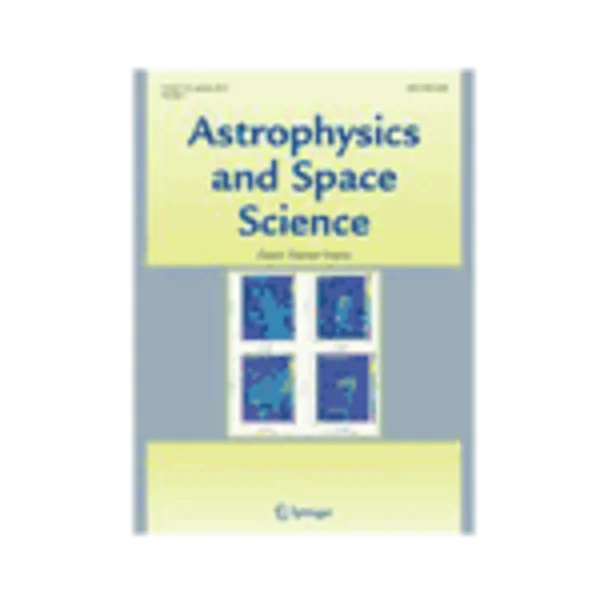-
equilibrium points and stability in the restricted three-body problem with oblateness and variable masses
جزئیات بیشتر مقاله- تاریخ ارائه: 1392/07/24
- تاریخ انتشار در تی پی بین: 1392/07/24
- تعداد بازدید: 960
- تعداد پرسش و پاسخ ها: 0
- شماره تماس دبیرخانه رویداد: -
the existence and stability of a test particle around the equilibrium points in the restricted three-body problem is generalized to include the effect of variations in oblateness of the first primary, small perturbations ϵ and ϵ′ given in the coriolis and centrifugal forces α and β respectively, and radiation pressure of the second primary; in the case when the primaries vary their masses with time in accordance with the combined meshcherskii law. for the autonomized system, we use a numerical evidence to compute the positions of the collinear points l 2κ , which exist for 0<κ<∞, where κ is a constant of a particular integral of the gylden-meshcherskii problem; oblateness of the first primary; radiation pressure of the second primary; the mass parameter ν and small perturbation in the centrifugal force. real out of plane equilibrium points exist only for κ>1, provided the abscissae ξ < v(k-1)/β . in the case of the triangular points, it is seen that these points exist for ϵ′<κ<∞ and are affected by the oblateness term, radiation pressure and the mass parameter. the linear stability of these equilibrium points is examined. it is seen that the collinear points l 2κ are stable for very small κ and the involved parameters, while the out of plane equilibrium points are unstable. the conditional stability of the triangular points depends on all the system parameters. further, it is seen in the case of the triangular points, that the stabilizing or destabilizing behavior of the oblateness coefficient is controlled by κ, while those of the small perturbations depends on κ and whether these perturbations are positive or negative. however, the destabilizing behavior of the radiation pressure remains unaltered but grows weak or strong with increase or decrease in κ. this study reveals that oblateness coefficient can exhibit a stabilizing tendency in a certain range of κ, as against the findings of the rtbp with constant masses. interestingly, in the region of stable motion, these parameters are void for κ = 4/3. the decrease, increase or non existence inthe region of stability of the triangular points depends on κ, oblateness of the first primary, small perturbations and the radiation pressure of the second body, as it is seen that the increasing region of stability becomes decreasing, while the decreasing region becomes increasing due to the inclusion of oblateness of the first primary.
مقالات جدیدترین رویدادها
-
استفاده از تحلیل اهمیت-عملکرد در ارائه الگوی مدیریت خلاقیت سازمانی و ارائه راهکار جهت بهبود
-
بررسی تاثیر ارزش وجوه نقد مازاد بر ساختار سرمایه شرکت های پذیرفته شده در بورس اوراق بهادار تهران
-
بررسی تأثیر سطح افشای ریسک بر قرارداد بدهی شرکت های پذیرفته شده در بورس اوراق بهادار تهران
-
بررسی تأثیر رتبه بندی اعتباری مبتنی بر مدل امتیاز بازار نوظهور بر نقد شوندگی سهام با تأکید بر خصوصی سازی شرکت ها
-
تأثیر آمیخته بازاریابی پوشاک ایرانی بر تصویر ذهنی مشتری پوشاک ایرانی (هاکوپیان)
-
نقش چشمه های آبگرم معدنی در رونق گردشگری با تاکید بر شهرستان مشکین شهر
-
مطالعه سیاست جنایی مشارکتی ایران در پیشگیری از قاچاق کالا و ارز
-
مطالعه تجربی تاثیرات نسبت های اختلاط و سن نمونه بر مشخصات مکانیکی بتن پلاستیک با استفاده از آزمایش سه محوری
-
مرتب سازی اسپایک های عصبی با استفاده از شبکه عصبی بدون استخراج ویژگی
-
بررسی گسترش خرافات و جادوگری در ایران با تاکید بر دوران صفویه و قاجاریه
مقالات جدیدترین ژورنال ها
-
مدیریت و بررسی افسردگی دانش آموزان دختر مقطع متوسطه دوم در دروان کرونا در شهرستان دزفول
-
مدیریت و بررسی خرد سیاسی در اندیشه ی فردوسی در ادب ایران
-
واکاوی و مدیریت توصیفی قلمدان(جاکلیدی)ضریح در موزه آستان قدس رضوی
-
بررسی تاثیر خلاقیت، دانش و انگیزه کارکنان بر پیشنهادات نوآورانه کارکنان ( مورد مطالعه: هتل های 3 و 4 ستاره استان کرمان)
-
بررسی تاثیر کیفیت سیستم های اطلاعاتی بر تصمیم گیری موفق در شرکتهای تولیدی استان اصفهان (مورد مطالعه: مدیران شرکتهای تولیدی استان اصفهان)
-
جرم شناسی جنوب
-
تنقیح مناط کتاب تاریخ تشیع در غرب اسلامی پس از شانزده سال، جامعه شناسی سیاسی دولت
-
تحلیل تفسیری مفهوم «صراط مستقیم» در سوره فاتحه با تمرکز بر تفسیر المیزان علامۀ طباطبایی رحمۀ الله علیه
-
environmental and economic analysis of selected pavement preservation treatments
-
preparation and characterization of tio2 fe2o3 nanocomposite by sol gel method




سوال خود را در مورد این مقاله مطرح نمایید :